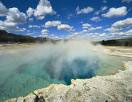An American Safari

Yellowstone is nature at its most grand. It has ten thousand geothermal wonders, half of all that exist in the entire world.
Two thousand buffalo. Twenty thousand elk. Moose, wolves, bighorn sheep, antelope, cougars, coyote, mule deer, grizzly bears and black bears....and those are just the larger critters. Are feathers your preference? Yellowstone is known to America's 46 million birders for its trumpeter swans, osprey, bald eagles, golden eagles, white pelicans, sandhill cranes, great blue herons, Canada geese, ravens, magpies, killdeer, yellow-headed blackbirds, dippers, and more. Even if you can't tell a bluebird from a duck you'll get a kick out of the variety!
Undoubtedly, much of the reason Yellowstone is a favorite destination with all the wondrous sights, it is also the sounds of the place the whoosh and gurgle of exploding geysers, the bubbling, plopping sound of mud pots, the giggle of kids when seeing these things for the very first time. Clark's Nutcrackers and huge black ravens fly overhead, making their distinctive sounds, while nearby buffalo grunt their displeasure at having to move to remain in the shade. There's always something happening in the park that will inevitably provide unforgettable memories.

And then there are the stories...dinnertime is when you hear what everyone has seen and experienced during the day, and in Yellowstone that adds up to a lot. That would be true even if you only drove through the park and took the boardwalk strolls around the hissing pools and geysers. But the road system covers only two percent of what there is to see. Specially arranged tours take people off the roads and into the back country by seldom - used trails, and just north of the park boundary (still in the Yellowstone Ecosystem) by horse into the high country guided by fourth-generation Montana cowboys. You can also raft the Yellowstone River, racing through its Class Two and Class Three rapids. You can imagine the stories that spill out at dinner after these activities!
For all the natural history of the array of animals and geologic wonders, the park's human history is equally fascinating. Imagine the reactions of the Crow and Blackfoot and Shoshone Indians as they traveled through the parklands, and of John Colter (a former member of the Lewis & Clark Expedition) who is believed to have been he first white man to see this region-alone and in winter to boot! Luckily, there are better records of mountain man Jim Bridger marveling at the sights two decades later in 1825, and the reactions of those he spoke to afterward.
Pay a visit to a remarkable park that's a World Heritage site; a designated Biosphere Reserve; a 'super volcano' hundreds of times bigger than Mount St Helens (but, thankfully, with no threat of imminent rumblings); is headwaters of the longest undammed river in the nation; has 290 waterfalls of fifteen feet or higher; and is home to a thousand archeological sites.
Trip Write Ups
- Amalfi and Tuscany
- An American Safari
- Argentina: Latin Lovers and Tango!
- Costa Rica
- Cuba
- Dubai
- Egypt
- Graz - Austria
- Historic Quebec
- Holland at Tulip Time
- Japan
- Lake Como
- Lisbon
- Spellbound by Morocco
- Follow me North to Alaska
- A Passage to India
- Prague and Berlin
- Seabourn Odyssey ... Luxury Redefined
- South Africa
- Tahiti
- Vietnam, Laos & Bankok
- Nicaragua

